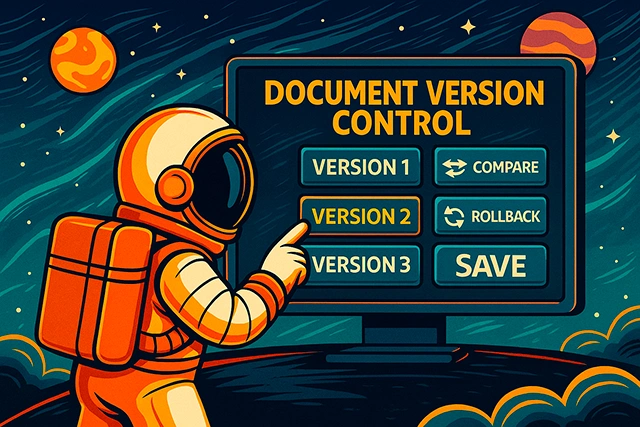What is Document Version Control Software and Why Your Business Needs It

In an age where digital documents are the backbone of most business operations, managing file versions manually is not just outdated it’s risky. One accidental overwrite, a missing edit, or an unauthorized change can disrupt workflows and compromise critical data.
Document version control software provides a structured solution. It keeps a complete history of every change made to a document, allowing teams to collaborate confidently, roll back to previous versions, and maintain transparency in the editing process. Whether you’re a small business or an enterprise with multiple departments, version control ensures your documentation stays accurate, secure, and organized.
In this guide, we’ll explore how version control software works, key features to consider, and which tools are best suited for your business needs.
Table of Contents
What is Document Version Control Software and Why Your Business Needs It
Managing documents in a modern business is no longer just about saving files it’s about collaboration, traceability, and control. Whether you’re updating contracts, sharing reports, or co-editing proposals, it’s easy to lose track of who changed what and when. That’s where document version control software comes into play.
This powerful class of tools helps businesses keep track of every change made to a document, ensuring teams stay aligned, errors are minimized, and older versions are always retrievable. From remote teams to compliance-heavy industries, version control has become essential for businesses that rely on accurate, collaborative documentation.
In this article, we’ll dive deep into how document version control works, why it matters, and which features to look for plus we’ll explore the best software options available today.

Key Features to Look For
When choosing the right document version control software for your business, it’s important to focus on the features that actually improve your workflow not just flashy extras. Here are the essential capabilities to look for:
Version History & Rollback
The ability to view all previous versions of a document and restore any of them is critical. Whether it’s correcting a mistake or recovering overwritten data, rollback ensures nothing is ever permanently lost.
Real-Time Collaboration
A good system allows multiple users to work on the same document simultaneously, without creating version conflicts. Real-time syncing ensures everyone is on the same page, literally.
User-Based Change Tracking
Every edit should be logged with the name of the editor and a timestamp. This provides a full audit trail essential for accountability, especially in legal or regulated industries.
Permission Control
Restrict who can view, edit, or approve changes. Access controls prevent unauthorized edits and protect sensitive data.
Automated File Syncing
Changes should be synced across devices automatically, especially if your team works remotely. This ensures that the latest version is always available no matter where you log in.
Document Comparison Tools
Built-in comparison tools let users visualize differences between two versions useful for catching small edits or major content shifts.
Cloud Integration
Most modern teams use tools like Google Drive, OneDrive, or Dropbox. A solid version control tool should integrate with your existing cloud ecosystem.

Best Use Cases for Teams and Businesses
Not every business handles documents the same way but nearly all can benefit from having structured version control in place. Here are some of the most common (and powerful) use cases where document version control software makes a huge impact:
Legal Teams
Law firms and in-house legal departments frequently work with contracts, compliance documentation, and sensitive records that require absolute accuracy. Version control ensures all edits are recorded, helping teams stay compliant, audit-ready, and legally protected.
Content & Marketing Teams
Writers, editors, and designers constantly revise content. Whether it’s blog articles, press releases, or design drafts, version control allows marketers to track creative changes, revert errors, and collaborate smoothly across revisions.
Product Development & Engineering
Teams building technical documentation like product manuals, engineering specs, or dev wikis need granular version tracking. This ensures every change is documented, and outdated versions don’t make it into production.
Remote or Hybrid Teams
When your team is spread across different cities or countries, manual file sharing becomes chaotic. With version-controlled documents in the cloud, everyone works on the same version reducing miscommunication and redundant work.
Finance & HR Departments
Departments that manage payroll data, employee records, policy documents, or reports benefit from detailed history logs and approval-based workflows. Version control also helps track policy changes and provides traceability for audits.
Top Document Version Control Software Options
Choosing the right document version control software depends on your team size, industry, and how your workflow operates. Below are some of the best options available, each offering unique strengths in collaboration, tracking, and integration.
Google Workspace (Docs + Drive)
Google Workspace offers real-time collaboration, automatic version history, and seamless cloud access. It’s a go-to choice for teams already working within the Google ecosystem. Every change is saved as a version, making it easy to review or restore previous edits.
Microsoft OneDrive for Business + Office 365
Ideal for businesses using the Microsoft 365 suite, OneDrive for Business provides deep integration with Word, Excel, and PowerPoint. It automatically tracks file versions both in the cloud and on synced local devices, giving teams flexibility and control.
Dropbox Business
Known for its simplicity and strong collaboration tools, Dropbox Business includes version tracking, document activity logs, and file recovery options for up to 180 days. It’s a reliable option for creative teams and SMBs needing intuitive version control.
Zoho WorkDrive
Zoho WorkDrive offers version history, team folders, and fine-grained access controls. It integrates with other Zoho apps, making it a cost-effective and scalable solution for growing teams that need built-in collaboration.
OnlyOffice
OnlyOffice supports real-time co-editing with deployment options on the cloud or on-premise. It’s especially useful for privacy-conscious organizations or those wanting more control over their document infrastructure.
If you’re also comparing tools for broader data storage needs, check out our full guide on cloud storage for business for deeper insights into secure and scalable document handling.
How Version Control Improves Team Productivity
In fast-moving work environments, productivity isn’t just about working faster it’s about reducing friction, avoiding repetition, and keeping everyone aligned. Document version control software plays a vital role in helping teams do exactly that.
Eliminates Version Confusion
Without a clear version history, teams often end up juggling multiple copies of the same document. This leads to errors, duplicated effort, and wasted time. Version control ensures that everyone is working on the latest file and if mistakes happen, earlier versions are just a click away.
Enhances Collaboration Across Departments
When team members from different departments collaborate such as marketing and legal or design and sales version control systems track each edit and streamline approvals. With real-time updates and change logs, handoffs become faster and smoother.
Provides Accountability and Transparency
Knowing who made what change and when is key to maintaining accountability. Version control logs every edit with a timestamp and user ID, which is essential for audits, quality assurance, and internal reviews.
Reduces Back-and-Forth on Email
Instead of emailing updated files back and forth risking someone editing the wrong version teams can work within one platform, using live comments and revision history. This reduces inbox clutter and miscommunication.
Supports Remote and Hybrid Teams
For remote teams, version control is especially important. It enables real-time collaboration and document syncing across locations and time zones, helping distributed teams function as seamlessly as in-house ones.
By creating structure and clarity around how documents are edited and shared, version control allows teams to focus on the actual work not on managing files.
Choosing Between Local and Cloud-Based Version Control
When implementing a version control system for documents, one of the key decisions businesses must make is whether to go with a local (on-premise) solution or a cloud-based platform. Each option has its strengths and your choice should align with your workflow, security requirements, and team structure.
Local (On-Premise) Version Control
Local systems store documents and version histories on your internal servers. This option is often favored by organizations that:
- Handle highly sensitive or regulated data
- Require full control over infrastructure and access
- Operate in industries with strict compliance protocols
However, local setups typically require more IT resources to maintain, and remote access may be limited without a VPN or private network.
Cloud-Based Version Control
Cloud-based solutions store everything online and allow teams to access, edit, and track documents from anywhere. They offer:
- Seamless collaboration across devices and locations
- Automatic syncing and version saving
- Easy scalability without hardware investment
This makes them ideal for remote teams and businesses looking for flexibility and minimal infrastructure management.
If you’re dealing with large media files or image-heavy documentation, cloud platforms become even more essential. For instance, businesses working with photography assets may benefit from cloud tools optimized for media. You can explore that further in our guide on the best cloud storage for photos.
Which One Should You Choose?
- If control and compliance are top priority → go local
- If flexibility, scalability, and cost-efficiency matter more → go cloud
- Many modern businesses even adopt hybrid models storing critical documents locally while handling day-to-day work in the cloud
Frequently Asked Questions
What is document version control?
Document version control is a system that tracks and records every change made to a document. It allows users to view, compare, and restore previous versions, ensuring transparency and consistency in collaborative workflows.
Why is version control important for businesses?
Version control helps teams avoid errors, prevent version conflicts, and maintain accountability. It ensures that everyone works on the latest version and that every change is documented which is essential for compliance, audits, and team efficiency.
Can version control be used with cloud storage?
Yes, most modern cloud storage services like Google Drive, OneDrive, and Dropbox include version control features. These platforms automatically save file versions and allow users to revert to earlier copies with just a few clicks.
What’s the difference between file backup and version control?
File backup creates copies of your data in case of loss or failure, while version control tracks the evolution of a document over time. Both are important, but version control is more focused on collaboration and document editing workflows.
Is version control secure?
When using trusted software especially cloud-based platforms with encryption and access controls version control is secure. Make sure the solution you choose supports user permissions, audit logs, and secure storage.
Final Thoughts
In today’s collaborative and remote-first business world, managing documents without version control is a risk you can’t afford to take. Whether you’re coordinating across departments, tracking sensitive edits, or simply trying to maintain a clean workflow, document version control software provides the structure and security modern teams need.
By choosing the right tool and understanding the difference between cloud and local options you empower your team to work smarter, faster, and with greater accountability. From enhanced productivity to better compliance, the benefits are clear.
As your business grows, so does the complexity of managing files and content. Implementing a reliable version control system is a foundational step toward building a more efficient, scalable, and future-ready organization.







